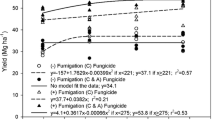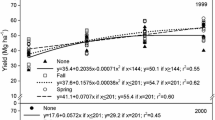Summary
Applications of chlorsulfuron (11.25 g ai ha−1) were made to wheat, flax, canola and lentils at spray volumes of 48, 108 and 2171 ha−1, and with metsulfuron methyl (6.00 g ai ha−1) at spray volumes of 48 and 2171 ha−1. Applications were made to the shoot only, the soil only and to the plant plus soil. Spectrofluorometric analysis was used to determine spray partitioning within the plant-soil system and foliar retention was related to efficacy. Fresh and dry weights of shoot material were determined 3 weeks after treatment. Flax and wheat were more tolerant of restricted-foliar applications than those made to the soil, the converse being true to canola and lentils. Applications made to the plant and soil were always the most deleterious. Foliar retention and efficacy did not correlate directly. Applications in 2171 ha−1 were generally more efficacious than those at 481 ha−1.
Similar content being viewed by others
References
Ambach R M and Ashford R 1982 Effects of variations in drop makeup on the phytotoxicity of glyphosate. Weed Sci. 30, 221–224.
Ayres P and Cussans G W 1980 The influence of volume rate, nozzle size and forward speed on the activity of three herbicides for the control of weeds in winter cereals.In Spraying Systems for 1980’s. Ed. J O Walker. pp 57–64. British Crop Protection Council Monograph, 24.
Blackman G R, Bruce R S and Holly K 1958 Studies in the principles of phytotoxicity. V. Interrelationships between specific differences in spray retention and selective toxicity. J. Expt. Bot. 9, 175–205.
Bryant J E and Courshee R J 1984 The effect of volume of application from hydraulic nozzles on the partitioning of a pesticide spray in a cereal canopy.In Application and Biology. Ed. E S E Southcombe, pp 201–210. British Crop Protection Council Monograph, 28.
Bukovac M J, Flore J A and Baker E A 1979 Peach leaf surfaces: Changes in wettability, retention, cuticular permeability, and epicuticular wax chemistry during expansion with special reference to spray application. J. Am. Soc. Hort. Sci. 104, 611–617.
Combellack J H and Matthews G A 1981 The influence of atomizer, pressure and formulation on the droplet spectra produced by high volume sprayers. Weed Res. 21, 77–86.
Doig R I, Carraro G A and McKinley N D 1983 DPX T6376 — A new broad spectrum cereal herbicide. 10th Intern. congr. Plant Prot., Brighton.
Hall J C, Bestman H D, Devine M D and Vanden Born W H 1985 Contribution of soil spray deposit from postemergence herbicide applications to control of Canada Thistle (Circium arvense). Weed Sci. 33, 836–839.
Holloway P J 1970 Surface factors affecting the wetting of leaves. Pesticide Sci. 1, 156–163.
Hutchinson J M, Shapiro R and Sweetser P B 1984 Metabolism of chlorsulfuron by tolerant broadleaves. Pesticide Biochem. Physiol. 22, 243–247.
Levitt G, Ploeg H L, Weigel Jr and Fitzgerald D J 1981 2 chloro-N[(4-methoxy-6-methyl-1,3,5-triazin-2-yl)aminocarbonyl] benzenesulfonamide, a new herbicide. J. Agric. Food Chem. 29, 418.
Merritt C R 1982 The influence of form of deposit on the phytotoxicity of difenzoquat applied as individual drops toAvena fatua. Ann. Appl. Biol. 101, 517–525.
Merritt C R 1982 The influence of form of deposit on the phytotoxicity of MCPA, paraquat and glyphosate applied as individual drops. Ann. Appl. Biol. 101, 527–532.
Muller F, Kang B H and Maruska F T 1984 Fate of chlorsulfuron in cultivated plants and weeds and reasons for selectivity. Med. Fac. Landbouww. Rijksuniv, Gent, 49(36), 1091–1108.
O’Sullivan P A 1982 Response of various broadleaved weeds, and tolerance of cereals, to soil and foliar applications of DPX 4189. Can. J. Plant Sci. 62, 715–724.
Palm H L, Riggleman J D and Allison D A 1980 Worldwide review of the new cereal herbicide — DPX 4189. pp 1–6. Proc. British Crop Protection Conf. — Weeds.
Peterson M A and Arnold W E 1986 Response of rotational crops to soil residues of chlorsulfuron. Weed Sci. 34, 131–136.
Sweetser P B, Schow G S and Hutchinson, J M 1982 Metabolism of chlorsulfuron by plants: Biological basis for selectivity of a new herbicide for cereals. Pesticide Biochem. Physiol. 17 18–23
Taylor W A and Merritt C R 1974 Preliminary field trials with 2,4-D ester, barban and triallate applied in spray volumes of 5–20 L/ha. Weed Res. 14, 245–250.
Taylor W A and Shaw G B 1983 The effect of drop speed, size and surfactant on the deposition of spray on barley and radish or mustard. Pesticide. Sci. 14, 659–665.
Western N M, Hislop E C, Herrington P J and Woodley S A 1984 Relationships of hydraulic nozzle and spinning disc spray characteristics to retention and distribution in cereals.In Application and Biology Ed. E S E Southcombe. pp 191–199. British Crop Protection Council Monograph, 28.
Author information
Authors and Affiliations
Rights and permissions
About this article
Cite this article
Shaw, G.B., McKercher, R.B. & Ashford, R. The effect of spray volume on spray partitioning between plant and soil. Plant Soil 100, 323–331 (1987). https://doi.org/10.1007/BF02370948
Issue Date:
DOI: https://doi.org/10.1007/BF02370948




